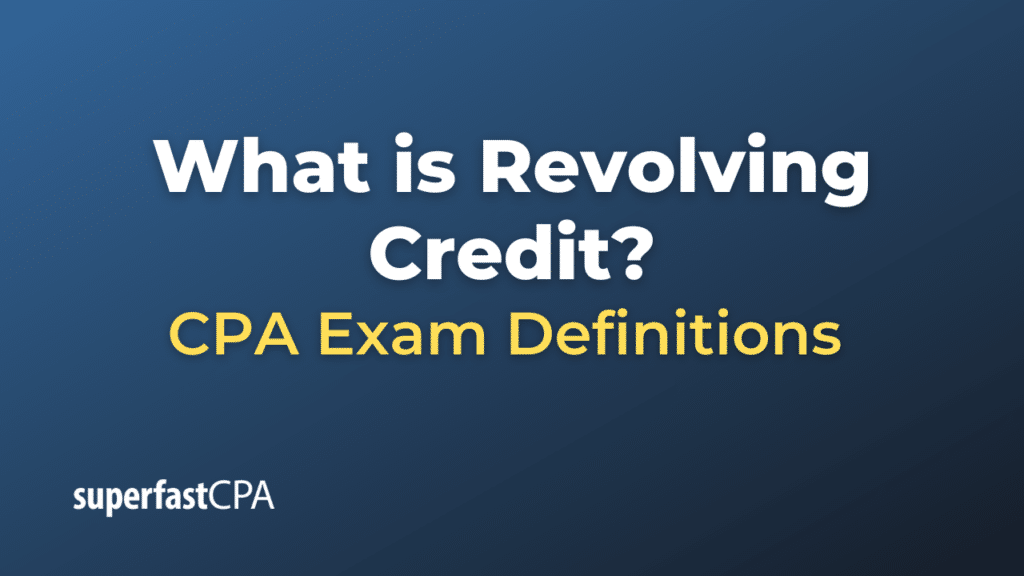Revolving Credit
Revolving credit refers to a credit arrangement in which a lender agrees to lend a maximum amount to a borrower, and the borrower has the flexibility to withdraw funds up to that maximum limit, repay, and borrow again as needed. The borrower only pays interest on the amount they’ve actually borrowed (or the outstanding balance) and not on the entire credit limit.
Some key characteristics and points about revolving credit include:
- Flexibility: Borrowers can use any amount up to their credit limit and can control their balance by repaying and borrowing as needed.
- Interest and Payments : Interest is charged only on the borrowed amount (i.e., the outstanding balance). Monthly payments can vary based on the amount borrowed and any additional charges or fees.
- No Fixed Term: Unlike installment loans, revolving credit doesn’t have a fixed end date. It remains open as long as the borrower and lender agree to the terms, and the account remains in good standing.
- Credit Limit : This is the maximum amount a borrower can use without facing penalties. Borrowers must be cautious not to exceed this limit.
- Usage Examples:
- Credit Cards: The most common form of revolving credit. Cardholders can make purchases up to a certain limit and can either pay off the balance in full each month, make minimum payments, or pay any amount in between.
- Line of Credit: Often used by businesses or individuals as a safety net for unexpected expenses or to bridge cash flow gaps. Similar to credit cards, but typically accessed via bank transfers rather than a card.
- Fees: Some revolving credit lines have associated fees, such as annual fees for credit cards or maintenance fees for lines of credit.
- Revolving vs. Non-Revolving Credit: In contrast to revolving credit, non-revolving credit requires borrowers to repay the borrowed amount over a fixed period with regular installment payments. Once repaid, the credit arrangement ends. Examples include auto loans or mortgages.
- Impact on Credit Score: Utilization of revolving credit can impact a person’s credit score. A high balance relative to the credit limit (high credit utilization rate) can negatively affect one’s credit score. Conversely, responsible use and timely payments can improve a credit score.
Overall, revolving credit provides flexibility for borrowers, allowing them to manage their cash flow needs more effectively. However, its convenience can also lead to overspending or accumulating high-interest debt if not managed carefully.
Example of Revolving Credit
Sarah has been approved for a credit card with a credit limit of $5,000. She decides to purchase a new laptop that costs $1,200 using this card.
Details:
- Credit Limit: Sarah’s maximum borrowing amount on the credit card is $5,000.
- Purchase: After buying the laptop for $1,200, she has used up part of her credit, leaving her with a remaining available credit of $3,800 ($5,000 – $1,200).
- Monthly Statement: At the end of the month, Sarah receives her credit card statement. It shows:
- Outstanding Balance: $1,200 (This is the amount she owes.)
- Minimum Payment Due: $30 (This is the least amount she needs to pay to keep the account in good standing. However, only paying this amount will result in interest charges on the remaining balance.)
- Total Credit Limit: $5,000
- Available Credit: $3,800
- Payment Choices: Sarah has multiple options:
- Full Payment: She can pay off the entire $1,200. If she does, she won’t be charged any interest, and her available credit will reset to $5,000.
- Minimum Payment: She can pay just the minimum amount due ($30). However, she’ll be charged interest on the remaining $1,170 ($1,200 – $30).
- Partial Payment: Sarah can also choose to pay any amount between the minimum payment and the full outstanding balance. For instance, if she pays $500, she’d still owe $700, and interest would be charged on that $700.
- Future Usage: After making her payment, Sarah decides to buy some books for $100. This further reduces her available credit. If she had made the full payment for the laptop earlier, her new available credit would be $3,900 ($5,000 – $100). If she only made the minimum payment, her available credit would be $3,700 ($5,000 – $1,200 + $30 – $100).
This example illustrates how revolving credit works. Sarah can continue to make purchases, repay them, and then borrow again, as long as she doesn’t exceed her credit limit of $5,000. The flexibility and convenience of this system are evident, but it’s also clear how easy it might be to accrue debt if one only pays the minimum amounts and carries balances with high-interest rates.













